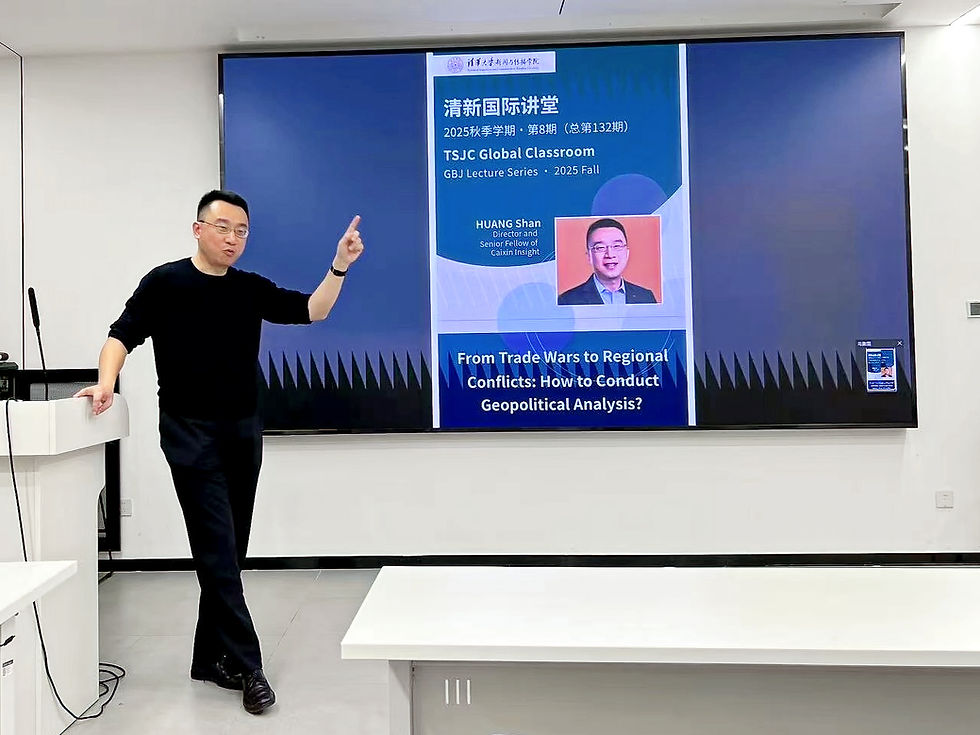GBJ students explore green transition in Inner Mongolia's Jungar Banner
- Bakhtawar Tauseef

- Oct 29
- 3 min read
By BAKHTAWAR TAUSEEF
Global Business Journalism reporter

Students from the Global Business Journalism program joined diplomats and foreign experts in a four-day visit to Inner Mongolia’s Jungar Banner area to study how China’s county-level development is being communicated to global audiences.

At the opening of the event, “International Dialogue: Engaging with people, Sharing Chinas stories,” Zhao Lijun of China Today described counties such as Jungar Banner as a foundation of Chinese civilization and building blocks of modern development. Zhang Zheng, Deputy Director of the New China Research Institute of International Communication at Tsinghua University said academic institutions can spread the word about such development.
“Universities and think tanks can help clarify communication goals, build content with local media and apply data and AI to evaluation," Zhang said.

Former UN Under-Secretary-General Erik Solheim, in a video message, praised the green-development principle as “lucid waters and lush mountains are invaluable assets,” adding that Inner Mongolia is at the forefront of China’s green transition with lessons for global development.
The delegation conducted site visits to observe ecological restoration and local industry. In Nuanshui town, which was once a barren area that suffered frequent droughts, the group saw 2,300 mu (about 380 acres) of apple orchards now producing roughly 10 million yuan in annual output.
From barren desert to thriving apple orchards. (GBJ photos by Bakhtawar Tauseef)
The project combines soil rehabilitation with eco-agriculture. The visiting students from Beijing expressed surprise at the rapid development in the formerly inhospitable area.
“Thailand is a country rich in fruit, but seeing such red and sweet apples grow in this cold, dry mountain region was really surprising,” said Thamee Titaree, a Thai student from Beijing Normal University.
The group also visited Zhuneng Mining Ecological Park, a restored open-pit mining area developed as a 4A scenic site.

Zhuneng Mining Ecological Park, (GBJ photo by Bakhtawar Tauseef)
“Before coming here, I imagined a typical ‘black’ mining area," a Beijing Normal University official said, "but what I saw was completely different, they have green hills, blue lakes, and a functioning ecosystem."
Operated by Guoneng Zhuneng Group, the park shows industrial heritage preservation, ecological restoration, and public education, telling the story of how a coal mine turned into a model of sustainable development.

Tradition meets modernity at Guoli Ceramics. (Photo by Jungar Banner Release)
Cultural industry and craftsmanship were also part of the itinerary. At Guoli Ceramics Co., visitors were shown how traditional processes are combined with modern techniques.
“The factory demonstrated how traditional culture can be given new life, with pieces that looked like artworks which also includes Mongolian elements,” said Jhane Cago, a GBJ student.
Traditional culture is given new life. (GBJ photos by Bakhtawar Tauseef)
The company produces high-end porcelain such as bone China and high-temperature reduction ceramics described as “thin as a cicada’s wing” and incorporates northern frontier culture, giant panda, and Chinese zodiac motifs.
Delegates also attended an evening program at the Meiji Changheli “City night life” pedestrian street, where they experienced local cuisine and entertainment in contrast of Tang-style buildings. Two students from Beijing Normal University, Thamee Titaree and Chiamaka Faustina Oraka said they liked the buckwheat-noodle dish known locally as wantuo, appreciating the savory soup and grilled squid.
The pedestrian street at night. (Photos by Jungar Banner Release)
Other activities included visits to the Jungar Banner Museum and the Jungar Yellow River Grand Canyon, where participants explored local history and regional features.
The program wrapped up with discussions on how county-level innovation can inform China’s broader development agenda. For Tsinghua’s GBJ students, the trip offered a close look at how local industries, from eco-agriculture to ceramics, are reinventing themselves for global audiences. As Inner Mongolia pushes to balance growth with green goals, Jungar Banner’s story is emerging as a case study of how China’s regional governments are turning development progress into soft-power capital.
The event was co-hosted by the Centre for Europe and Africa (China Today) of China International Communications Group (CICG), Tsinghua University-Xinhua Institute of International Communication, and the Publicity Department of the Jungar Banner Committee of the Communist Party of China, with support from the Yellow River Institute of Hydraulic Research, Yellow River Conservancy Commission of the Ministry of Water Resources.
Organizers said the series of dialogues and visits is designed to explain varied county-level practices and contribute local perspectives to international communication.


















Ce qui est intéressant avec Abonnement IP TV Belgique, c’est la façon dont le site vulgarise un sujet souvent perçu comme technique. On y retrouve des explications simples sur le fonctionnement de l’IPTV, les différentes solutions disponibles et les précautions à prendre pour un usage stable et sécurisé. Pour quelqu’un qui débute dans ce domaine, c’est une ressource claire et pratique.